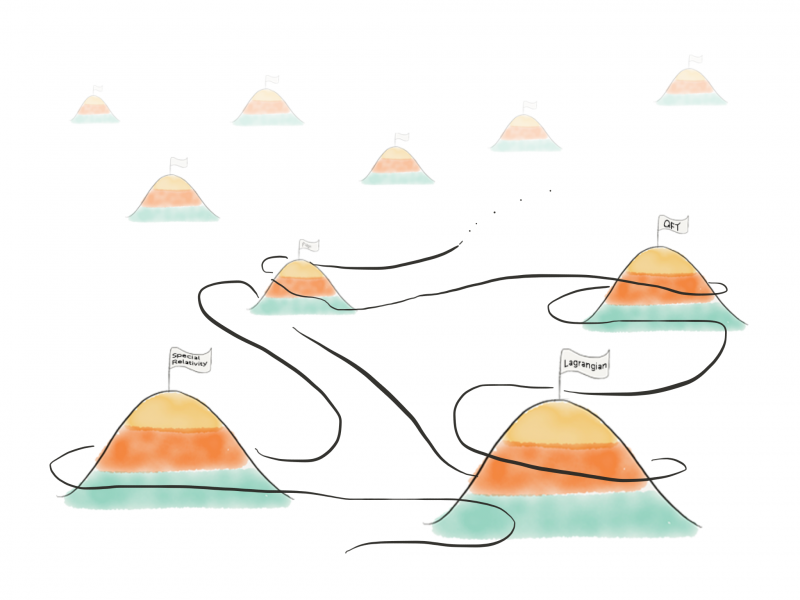Add a new page:
Textbooks and lectures are based on the assumption that students learn physics as follows:

In reality, no one learns physics like this. Learning physics a messy and very personal process. Everyone needs to find his own way through the vast labyrinth we call physics. Most of the time we don't understand a concept when we first hear about it. Understanding takes time. To understand a concept or a theory, we need to understand its relationship to other concepts. There is no clearly defined point when you have fully understood something. Instead, we can vaguely define different "layers".
Still, this is not a straightforward process. Instead, usually, we first hear about a concept while we try to understand something completely different. We then try to get a very basic understanding and return to the topic we were originally learning. After some time, the concept appears again in a different context and this time we learn it more seriously. Again after a while, we stumble upon a description of the concept, for example in a research paper, that is completely different from the one we learned from the textbooks. We revisit the concept again and start to understand it a high level of abstraction. The following picture sketches a more realistic learning path:

So here is a concrete story to make the idea explained above more concrete.
Sarah wants to understand modern physics. She starts by reading a book on classical mechanics and notices that a concept called "Lagrangian formalism" is somehow important. However, she can't really figure out what this formalism is all about. In the way the textbook she is reading presents it, the formalism appears almost like magic.
She opens PhysicsTravelGuide.com and searches for "Lagrangian". She learns that the Lagrangian is really something magical and used in topics as advanced as quantum field theory or quantum gravity. This sparks her interest even further. She then clicks reads the "Laymen" explanation for the Lagrangian formalism. After a few minutes, she understands that the Lagrangian formalism is based on a simple idea, namely that "nature is lazy".
Now she wants to understand how we can use this idea concretely. She reads the "Student" layer explanation and starts how to use the Lagrangian to solve concrete classical mechanics problems.
When she sees the Lagrangian that yields the Newtonian equations of motions she starts to wonder: "Where does this Lagrangian come from?" In the FAQ section, she then learns that this Lagrangian is simply what we get when we approximate the Lagrangian of special relativity for small velocities. The Lagrangian of special relativity is simply the "proper time".
She open new browser tabs to get at least some understanding of what "special relativity" is all about and what this curious "proper time" is. After reading the corresponding laymen sections she returns to learn more about the Lagrangian formalism. After a while, she starts wondering: "Okay the Lagrangian of special relativity is quite natural, but why do we minimize at all? Why is nature lazy?"
Again, in the FAQ section, she learns that this is only approximately true. Nowadays, using the "path integral formulation" we understand that nature actually goes all possible ways. The minimal paths are only those that are dominant and most probable for classical systems. Again she opens a new browser tab to understand what this "path integral formulation" is all about.
Of course, during her journey, she will revisit all the topics she stumbled upon hearing over and over again. For example, she will only understand the path integral completely after learning some quantum field theory.
Nevertheless, she has already learned many deep connections at an early stage. Every time she stumbled upon a new concept, she had the possibility to get a quick explanation that was catered to her current level of understanding. This way she never got lost and was able to continue her journey.
This wiki exists to lower the entry barrier to technical topics for laymen, students and researchers alike.
At a certain point everyone realizes that simply attending some lecture or reading the one book that an expert recommended is not how you truly understand a topic. Learning is a messy process and works differently for different people. However, there are a few steps in the learning process that anyone who gets a deep understanding needs to climb. By recognizing them and then organizing your learning process according to them, you can speed up your learning process enormously.
The biggest mistake and the most common reason for feeling lost and confused during the process of learning a new topic is the attempt to jump over one of these steps. For example, most of the time the attempt to start at the highest layer is almost always a huge mistake.
The steps on the ladder from knowing nothing to expert knowledge can be summarized as follows:
This wiki exists to give you the right tools and resources for the various phases. By organizing each page according to the various steps on the ladder to understanding, we want to help systematize the learning process and make it easier.
When introduced to a new idea, always ask why you should care. Do not expect an answer right away, but demand one eventually. Ravi Vakil
It should be recognized instead that student intuitions are essential cognitive resources developed through years of real-world experience. We understand the world by mapping events into the mental spaces of our imagination. The chief problem in learning physics is not to replace intuitions but to tune the mapping to produce a veridical image of the world in the imagination.MODELING THEORY for Math and Science Education by David Hestenes
Learning physics means more than learning formulas and schemas, it means learning a different approach, a different frame of mind. Uses of cognitive science to science education by W. Jung